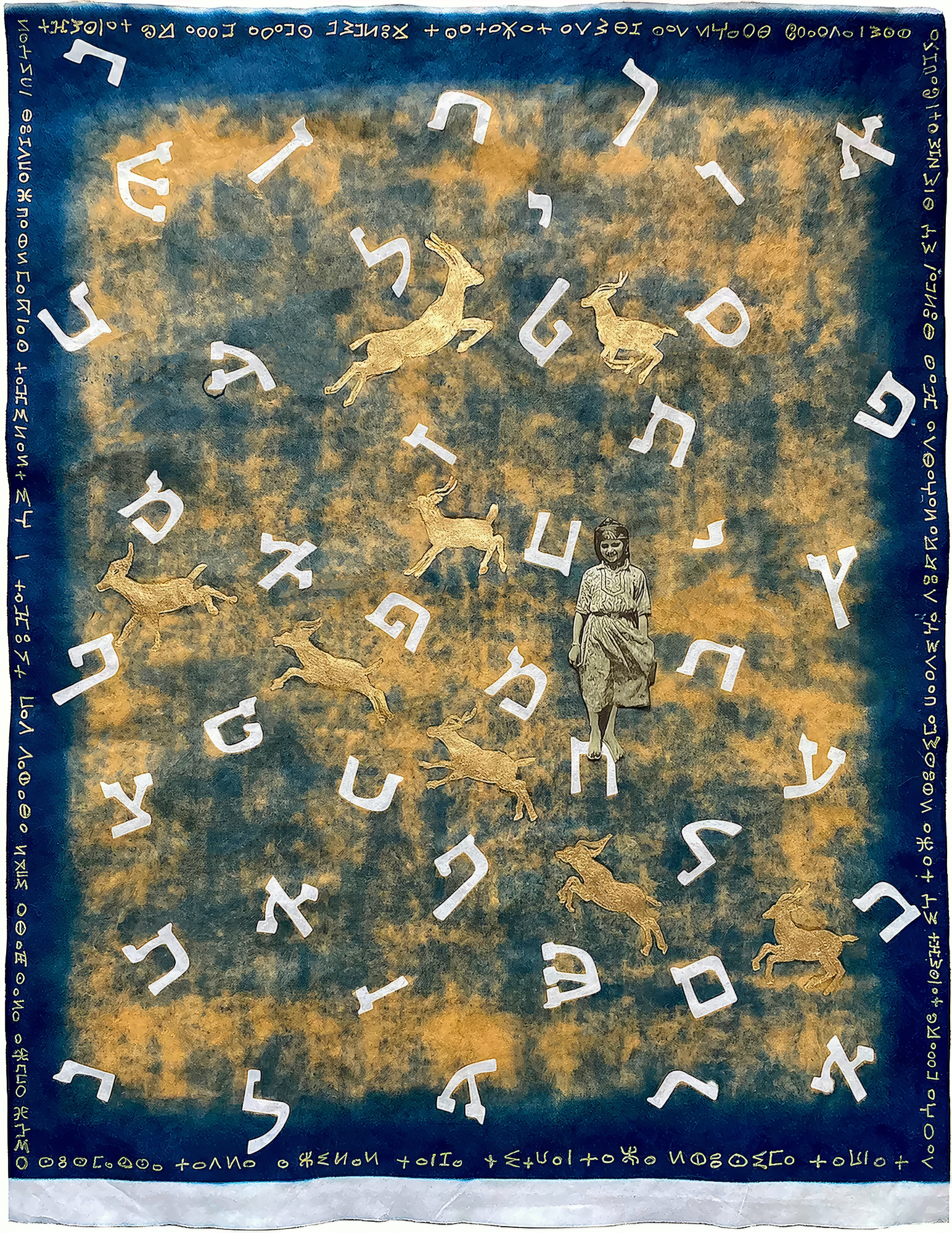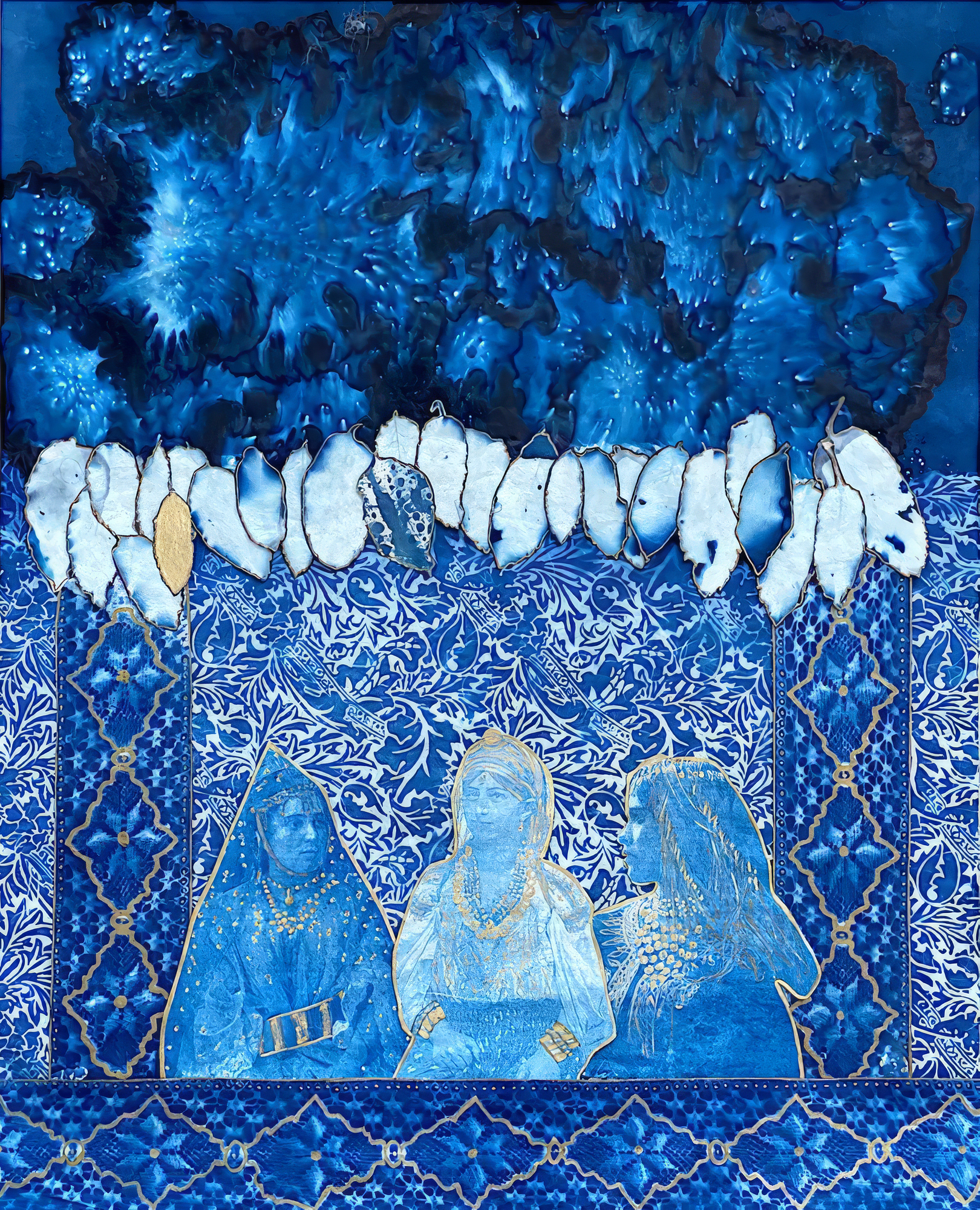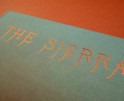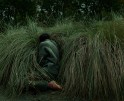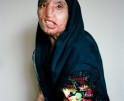New England Portfolio Review: Fruma Markowitz: Searching for the Kahinah
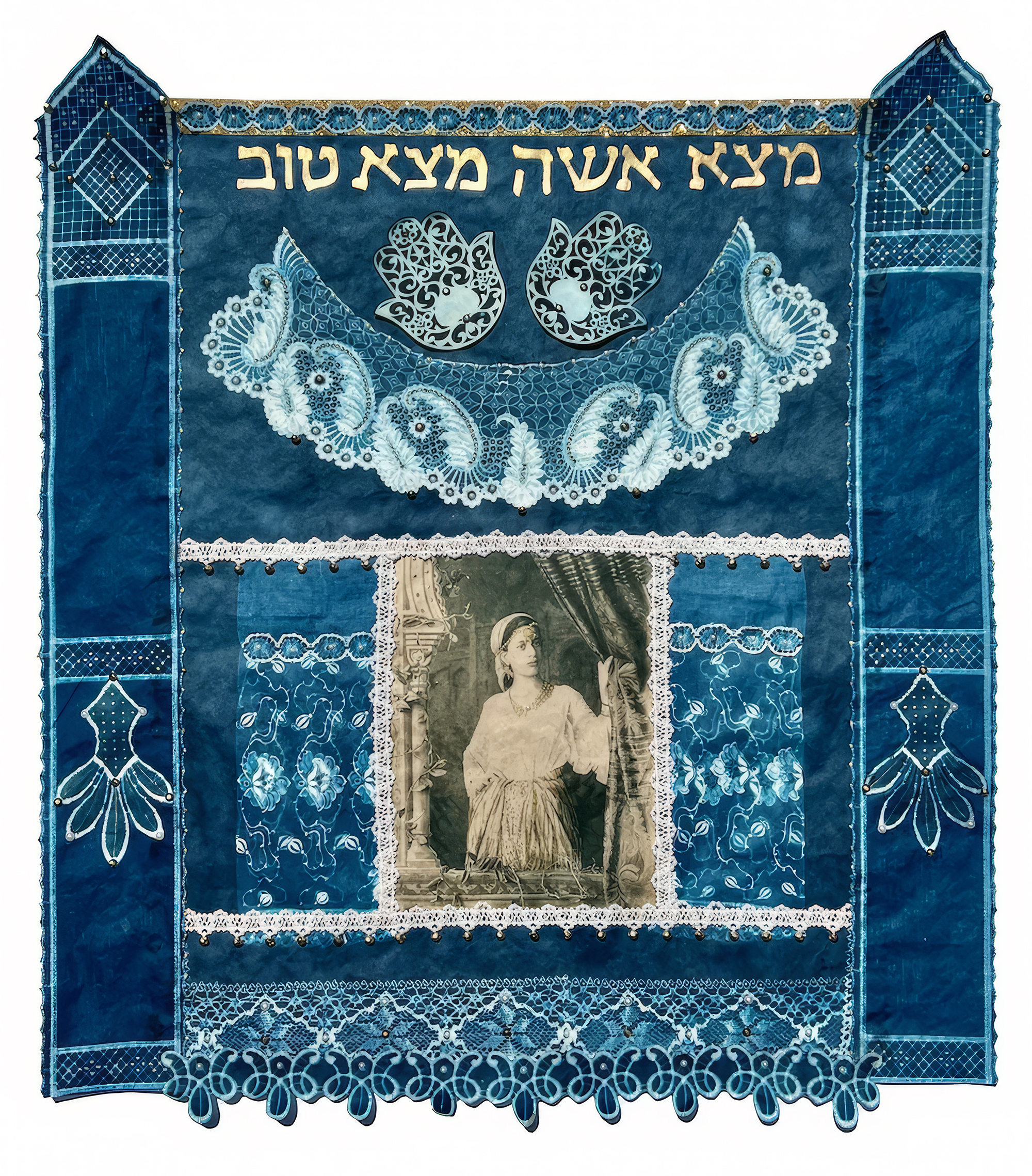
©Fruma Markowitz; Bride, Waiting, cyanotype collage on Hahnemühle Sumi-e paper, stencils, fabric trim and sewn beaded elements, with gold ink embellishments
For the past few days, we have been looking at the work of artists with whom I met at this year’sNew England Portfolio Review,. Much appreciation to The Griffin Museum of Photography and the Photographic Resource Center for organizing the reviews this year, and for providing a great opportunity to share and view some amazing photographic work. To wrap things up, we have Fruma Markowitz.
Fruma Makowitz has always been fascinated by what her childhood self called “the olden days.” Spellbound by faded sepia portraits of family members she had never met, and hearing her parents’ stories about escaping pogroms and poverty, she acquired an acute sensitivity to human suffering, alongside a deep awareness of the way time works to both elucidate and obscure human experience. Photography, as a socalled “time-based art” became the perfect medium for her to create her own visual interpretation of time. Her father put a Kodak Brownie camera in her hands when she was seven, and she was hooked forever.
Today, her photography practice focuses on historical, experimental and hand-made processes, with an emphasis on cyanotype, mixed-media collage and lumen works. Family life, womanhood, cultural history, memory and shared legacies are where she mostly draws inspiration for making images.
Fruma is a member of several artist organizations locally in CT where she lives and regularly shows her work, including the Silvermine Guild of Artists, the Artists Collective of Westport, The Kerschner Gallery, The Bendheim Gallery, Carriage Barn Art Center, the Ridgefield Guild of Artists, the Shoreline Arts Alliance and the Rowayton Arts Center. She has taught photography to women in crisis at the Project Return home in Westport and to cancer survivors at The Creative Center in New York City.
Fruma’s work has been shown nationally at the SoHo Photo Gallery in NYC, the New York Center for Photographic Arts, the Griffin Museum of Photography, the Southeast Center for Photography, The Halide Project, Light ArtSpace Gallery in New Mexico, and was invited by curator David DeMelim to participate in “Behind the Lens,” a show honoring contemporary female photographers at RICPA in February, 2023. In January 2024 Michael Kirchoff, editor-in-chief of Analog Forever Magazine, chose one of her lumen pieces for his Top Ten photographs of 2023, and a full portfolio spread was featured in the August 2023 issue of DekUnu Arts Magazine. She was published in Issues #33 and #35 of The Hand Magazine, and selfpublished a book of her documentary travel photographs, “Synagogues Along the Danube,” in 2019. In 2022 and 2023 she won Honorable Mention in two categories of the Julia Margaret Cameron Award for Women Photographers, in Alternative Processes and Women Seen by Women. Fruma is the recipient of two materials grants (2020, 2022) through the Drew Friedman fund in Westport. She completed an Artist Residency at the Weir Farm Historic Nature Preserve in Wilton, CT, in September, 2022.
Fruma was a member of the first graduating class to earn a BFA in photography at the Bezalel Academy of Art & Design in Jerusalem, Israel, and worked as a commercial photographer and photography teacher in Tel Aviv where she participated in several group shows. She returned to the U.S. to pursue a Master’s degree in Interactive Technology at NYU, which led to a great day job for 25+ years in digital marketing. Additional recent studies at ICP, Harvard Artists Extension, EXP22 Experimental Foto Festival, and Maine Media Workshops were with Brenton Hamilton, Anne Eder, Annette Golaz, Bridget Conn, Stig Marlon Weston, Marcy Palmer, and Rachelle Bussieres. Currently she is working with cyanotype on paper and textile-based multi-media processes on a long-term project, “Searching for the Kahinah,” engaging with the lives and culture of Jewish, Muslim and Berber women of North Africa.

©Fruma Markowitz; Dahiya al Kahinah (The Seer), Wet cyanotype with table salt and turmeric, with cyanotype collage elements and gold ink embellishments on Hahnemuhle Rice paper
Searching for the Kahinah
“Searching for the Kahinah” is part travelogue, part archive, part fact, part flight of fancy, but mostly a visual journey through the many interwoven narratives comprising the unique fluidity of culture and tradition characteristic amongst women of the Maghreb (North Africa). During my own travels in Morocco I learned how Jewish, Muslim, and Amazigh (Berber) women shared a confluence of stories and myths, religious beliefs and practice, personal adornment and handcraft design for centuries – and became intrigued. Because, I find it so very remarkable that groups we in the West consider at odds with one another, in fact lived side-byside with respect for years, mostly because the women amongst them made it so. This concept is foundational to my project.
The work draws additional inspiration and imagery from a vast archive of images I discovered dating from the turn of the 20th Century. The photographs depict women, clearly labeled as “Jewish,” “Arab Muslim” or indigenous “Berber.” The photographs were made by male photographers, at a time when North Africa was being colonized by Europeans. They were sold commercially as postcards for tourists; “souvenirs” of a way of life considered antiquated, “barbarian,” and destined to be replaced by a superior (French) Empire.
As a Jew, and a woman, and a photographer, I find in these portraits and what I’ve learned about them, a significant emotional point of reference for my own identity and experience, irrespective of personal background. The Kahinah, who was a real historical figure of the 8th Century, represents female strength, heroism and leadership for Jewish, Muslim and Amazigh people. She is my muse.
My imagination and a pair of scissors literally cut the portraits out of this posed, imposed reality, and offers them another world – a woman’s world – where my historical research coupled with their shared connective tissue can be realized within a new context, far away from the romanticized version of them as “other.” Cyanotype, with its rich blueness, is, for me the appropriate foundational process to use in making these works. Blue is not just any color in the cultures of North Africa and the Middle East. In this part of the world the color blue represents a deep spiritual force that protects against the Evil Eye, of which women are to a large extent, the arbiters thereof.
My images aim to turn all that on its head, to reverse the gaze that is male. Here I’m offering a point of view that, between moments of factual observation and flights of fancy, considers an alternative space where women look directly back and hold the gaze.
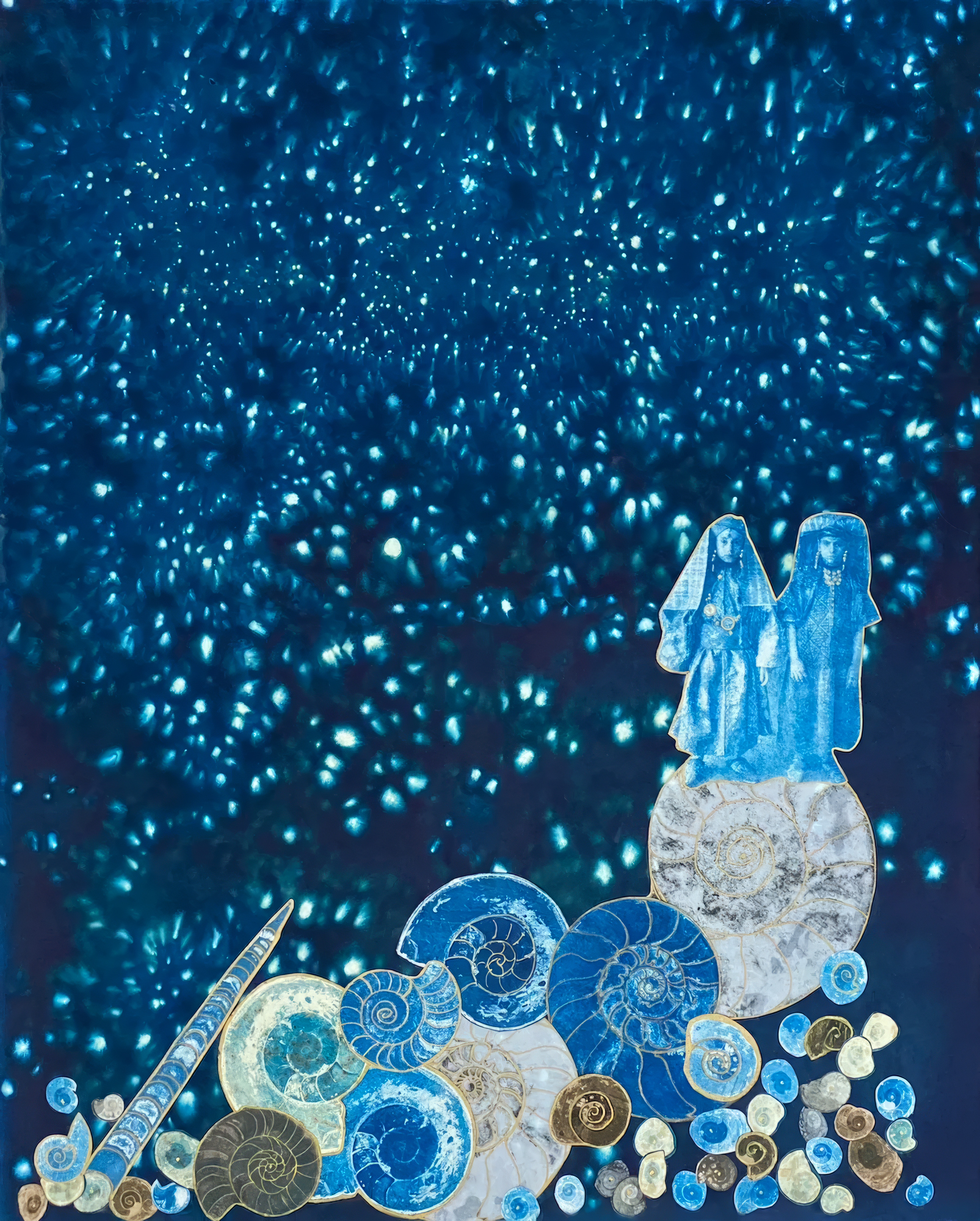
©Fruma Markowitz; Fossil Finders, Wet cyanotype with table salt and turmeric, with toned cyanotype collage elements and gold ink embellishments on Hahnemuhle Sumi-e paper
Daniel George: Tell us how this project began. When did you come across these archival portraits, and what led to the creation of the work?
Fruma Markowitz: “Searching for the Kahinah” was a personal response and identification with the women of North Africa after I spent a month in Morocco in January 2020. I had spent 12 years of my young adult years living in Israel, where I also attended the Bezalel Academy of Art to earn my BFA in photography, and where I first became very aware that over 50% of the Jewish population of Israel was comprised of Jews of Color – from Morocco, Algeria, Tunis, Libya, Iraq, Syria, Iran, India, Yemen, Ethiopia. During my month in Morocco I also became aware that the story of Jews and Muslims has not always been contentious, in fact for hundreds of years in Morocco they had lived side by side in friendship and cooperation, especially among the tribes of the mountains, the Amazigh peoples who are comprised of both Jews and Muslims. And, to no surprise, I learned that many of the customs, beliefs, practices and crafts of these people were also shared, mainly by the women, between Jews and Muslims. I needed to learn more. Upon my return to the US, and in the wake of COVID, I began to comb the Internet for sources and found a huge collection of postcard photographic portraits, mainly of women-Jewish and Muslim-taken by French photographers in the late 1800’s and early 1900’s, when France was busy colonizing much of North Africa. These are the images that I am using in my work.
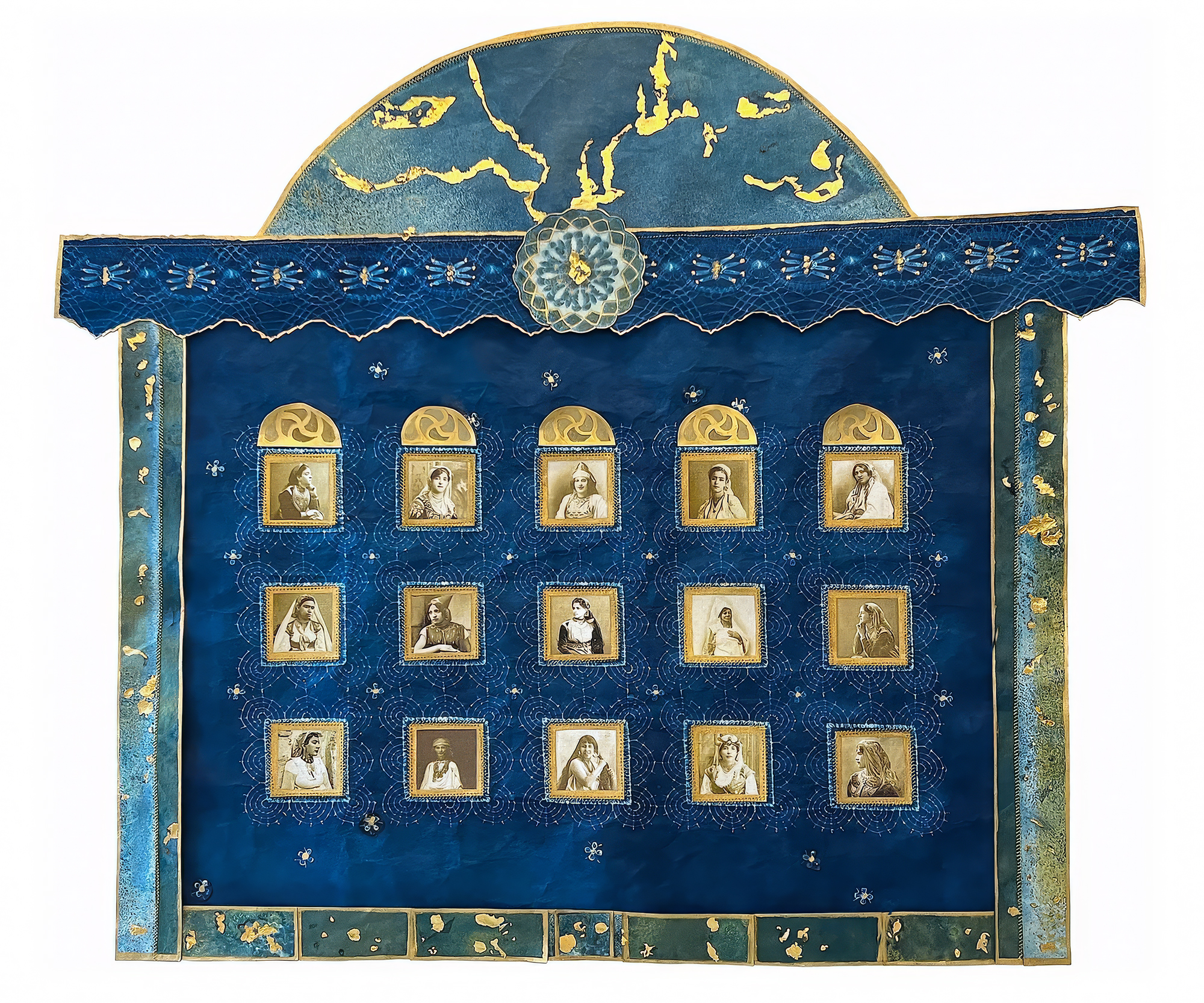
©Fruma Markowitz; Gossip in the Mellah, Cyanotype Collage composed of classic and wet Cyantoype components, with photographs printed on cotton interfacing machine stitched onto paper substrate, embellished with gold stitching, gold leaf and ink pen markings
DG: I was immediately drawn to the distinct characteristics of the material components of your images. In your statement you mention the use of the cyanotype as the “foundational process” and you go on to explain its symbolism within the work. Tell us more about the importance of materials in these images—from toning to the use of gold leaf and other embellishments.
FM: Every artist develops a unique visual vocabulary with which to communicate the essential message of their work. I was already evolving from traditional, representational (digital) photographic work and leaning towards experimental and historical processes before the trip to Morocco. I pretty much made a complete transition, mainly working with cyanotype, when I returned, but making “typical” botanical studies as all beginners tend to do with this medium. Once I uncovered the archive of postcards, I immediately made the connection in my mind between the women, the historic situation, and the blue of cyanotype. One of the towns I had visited in the north of Morocco, Chefchaouen, is completely painted blue. The houses, the sidewalks, the walls, everything is blue! It’s the blue of cyanotype, and the blue that is incorporated everywhere in the Middle East, and even throughout the Mediterranean to ward away the “evil eye.” This is a very essential practice and belief, and it runs across cultures and beliefs. So cyanotype was a natural jumping off point in terms of color, and that color’s significance in the culture I am portraying. The photographic images of the women are direct cutouts from the postcard archive, and sometimes I use tea and coffee to give them a contrast, have them stand out within an all blue background. Tea and coffee are also very significant in the culture, as they symbolize hospitality, the welcoming of guests into the home, a task that is mainly associated with women. Lastly, the textures of fabric and textile, also mostly the domain of women, in the type of dress they are clothed with in these photos, which I found to usually be one of two types – wedding finery and traditional tribal costume – often some combination of both, greatly inform the textures and use of real fabric trim I use in my pieces. I don’t pretend that what I’m doing is 100% “authentic” any more than the source photographs are. In fact the male photographers often hired models and dressed them up in their studios in order to make them seem “exotic” so tourists would purchase the images as souvenirs. In a way I’m exaggerating this detail, as a commentary on how these women were “othered” by the photographers. Some might argue I’m doing the same…though I feel that my choice of materials, and my placing of the portraits within a color field and textural matrix reflective of lived experience, is my artist’s prerogative for using imagination to tell an authentic story. The gold leafing and lettering comes from the real tradition of making and wearing gold jewelry. The Jewish people in towns and rural areas were masters of this trade, and the women literally wore their dowries of gold and silver when they got married. Quite a few of the pieces in this series reference wedding traditions, and are heavily decorated if you will, with gold and silver leaf, gold stitching, and more blingy elements.
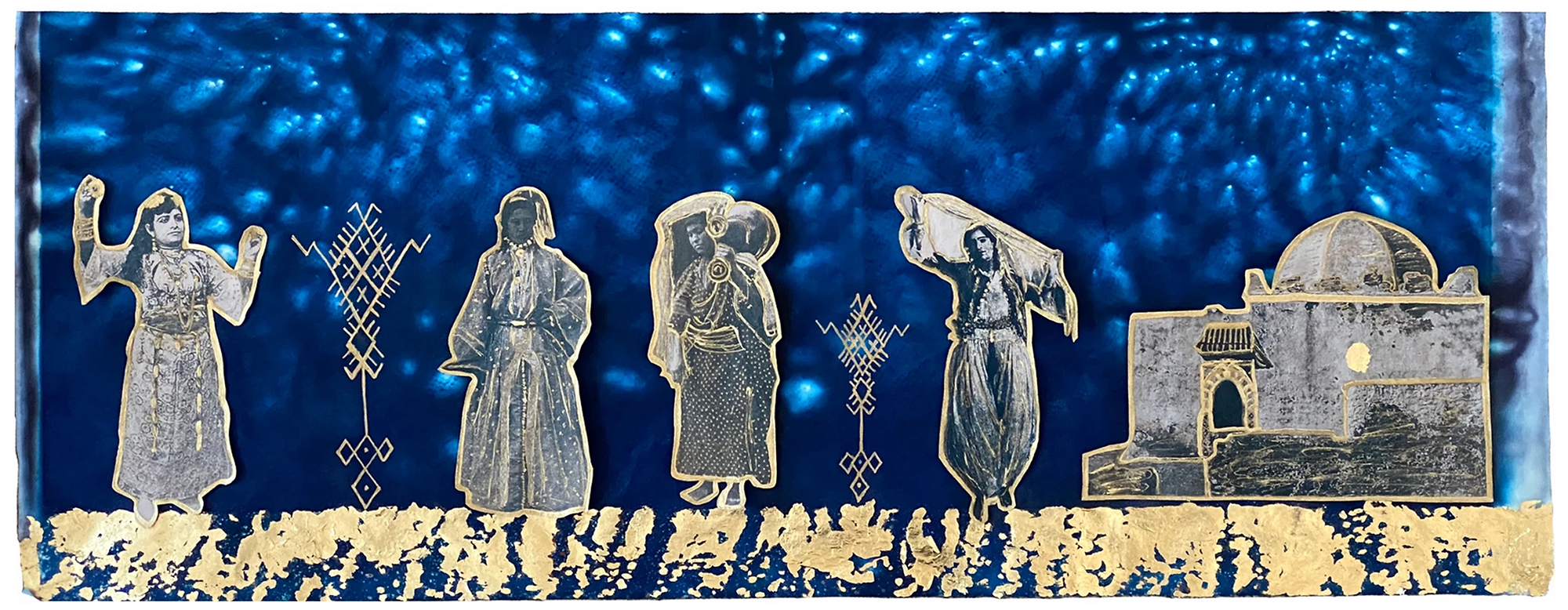
©Fruma Markowitz; Hilloulah to the East, Wet cyanotype with table salt and white vinegar, with toned cyanotype collage elements and gold leaf/ink embellishments on Hahnemuhle Sumi-e paper
DG: You write that these portraits have served as an “emotional point of reference for [your] own identity and experience” as a Jewish woman. Would you mind sharing more about this?
FM: October 7, 2023 was a turning point for world Jewry, and for me as a Jewish woman, watching those events unfold, and the torrent of antisemitic hatred bursting throughout the world shortly after, and still ongoing, was especially painful. My Kahinah project is rooted in the fundamental belief, and proof in history, that people can live together despite their deep-rooted differences. The women of North Africa, Jews together with Muslims, lived in harmony for centuries. So I look at the troubles we face right now, and ask myself several questions: As a woman I ask – What if all of this was in the hands of women? Would all of this mess be handled differently? Would there be more compassion, more cooperation, and less violent conflict? And secondly, as a Jew, I ask why the hatred against my people persists, after hundreds of years, after not only the Holocaust in Germany, but many other horrific times for us in history, and taken to new frightening levels apparently also in our own time? As an artist I ask, what story can I tell in my work that will amplify the voices of women, and especially of Jewish women, who have been either silenced or misrepresented in history, and yes in art history as well. The women in the postcards are an expression of how Jewish, and Muslim, women were and are viewed by the photographers who took their pictures, and perhaps a continuation of how they were depicted by painters of the Orientalist school in the centuries just before the photos were made (Delacroix, anyone?). I’ve lately been looking at these paintings as well, and am beginning new work, almost fully executed with textiles, that will take a deeper dive into how Jewish and Middle Eastern women have been portrayed in art history, some of the tropes and memes that I believe inform us about the roots of antisemitism as it has evolved in today’s world.
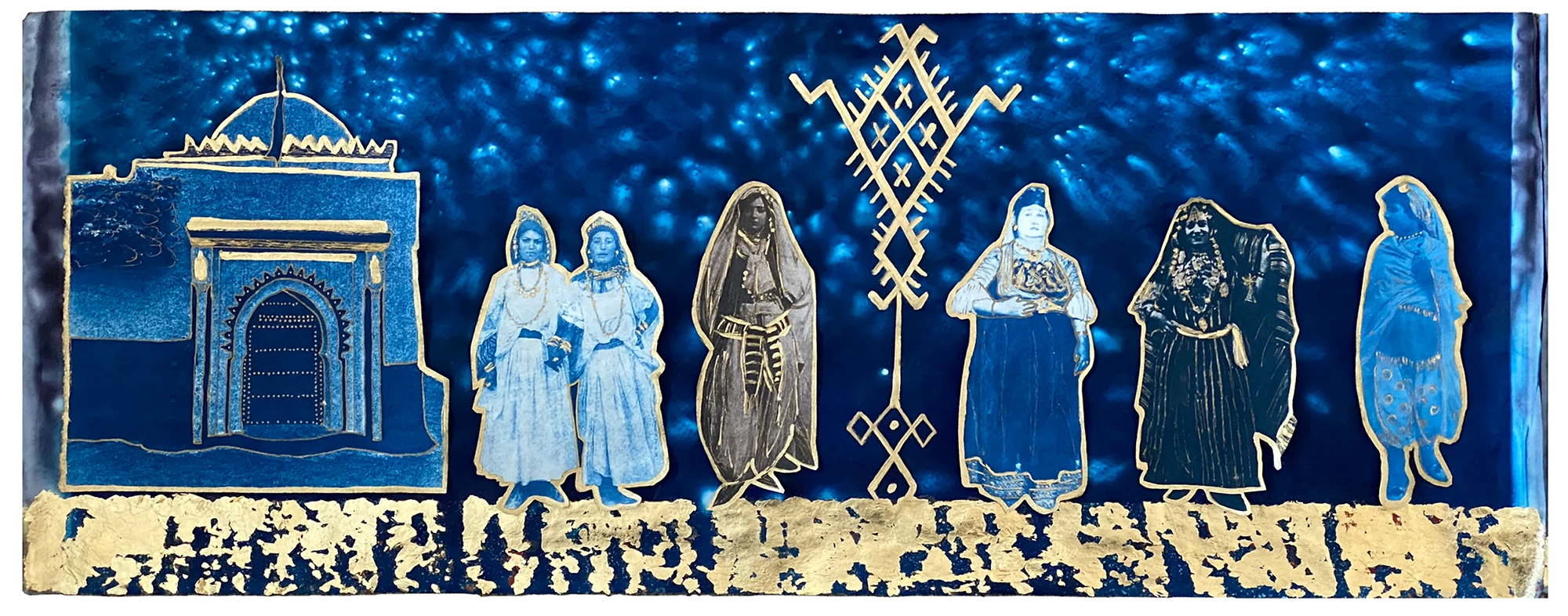
©Fruma Markowitz; Hilloulah to the West, Wet cyanotype with table salt and white vinegar, with toned cyanotype collage elements and gold leaf/ink embellishments on Hahnemuhle Sumi-e paper
DG: You mention that this is project is a sort of visual journey, but you physically traveled and spent time in Morocco while making this work. I sometimes think about the difference between remote research and discovery versus actually traveling to and spending time in a place. Are you able to identify the ways that your travels influenced this series? What did your presence in Morocco contribute?
FM: Being in Morocco brought alive the stories and traditions shared with me by my Moroccan friends during the 12 years I lived in Israel in my young adulthood. I was always invited home for weekends and various holidays, where I heard the music, ate the food, observed the visual things an artist always sees, and was drawn into the magic of my friends’ family traditions and hospitality. Morocco was once the home for over 250,000 Jews, and today there remain only two to three thousand. This is true for all the Jewish populations that once lived in Arab lands, they were either forced to leave or decided it was safer to do so, after Israel became a state in 1948. So, in fact, much of my personal journey on the ground in Morocco was spent “looking for ghosts.” I visited and photographed about 13 synagogues, most of them refurbished by the Moroccan government as museums and no longer in use, and 8 or 9 Jewish cemeteries. I walked through the Jewish “Mellah” or neighborhoods in cities, towns, remote Atlas Mountain villages where they had lived, observing how the architecture of their homes is distinctly different than that of their Muslim neighbors, which I’ve later also captured in my piece “Gossip in the Mellah.” I photographed, and sometimes purchased, textiles, jewelry, ceramics and woodworking that I’ve used in some of my pieces, or at a minimum studied the designs and symbols shared in the crafts made by women, and later incorporated those into some of my work. I’ve carefully researched some of the myths and stories, as well as the religious practices, since my return. These form a wellspring of visual and cultural fodder for much of the work, as some of my pieces are based on a specific story, or a specific practice, again shared by both Jewish and Muslim women. One example is the practice of making a pilgrimage to the graves of certain “saints” at auspicious times in the calendar. The saints are interchangeable between Jews and Muslims – Muslims visit Jewish saints and Jews visit Muslim saints. They ask or pray for love, marriage, fertility, healing from sickness, the safe travel and return of loved ones, and for peace. It is a practice still carried out today, and we saw people visiting graves, lighting candles, praying. My piece “Hiloulah to the West and to the East” captures this time of dance, song and prayer. (Hiloulah means pilgrimage.)
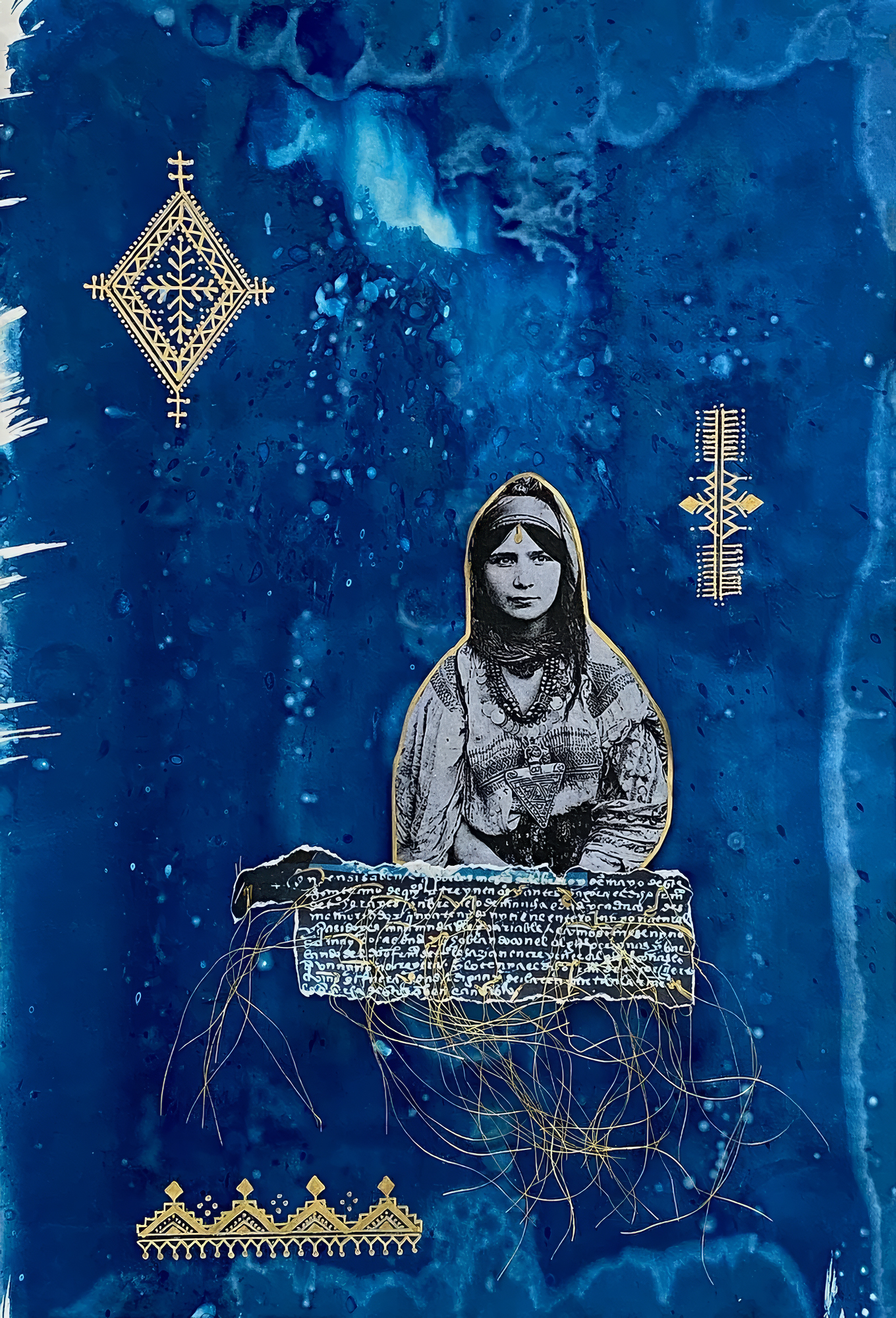
©Fruma Markowitz; I Was A Jewess of Debdou, Wet cyanotype with table salt and soap bubbles, with cyanotype collage elements, gold ink and sewing thread embellishments on Hahnemuhle Rice paper
DG: Toward the end of your statement you describe your intentions to reverse the male gaze by “consider[ing] an alternative space where women look directly back and hold the gaze.” What compelled you to highlight these narratives and open alternate dialogues surrounding these women and their cultures and traditions? Why do you feel this is important?
FM: There are endless lands, traditions and peoples of the world that we in the West have either maligned or simply ignored. In the most personal way, I’ve had a knee-jerk reaction to preconceived notions about people, especially my people, that ultimately lead to prejudice, hatred, and in the worst cases, aggression and violence. Having come of age in the age of Feminism, that’s probably my primary deep-seated sensitivity in terms of my own experience as a woman, and a sense of being aligned with all women in their struggles to be heard and respected. And as a Jewish woman, I think it is important to spread the word that we are not all cut from the same white, European cloth. Although my own family is from that tradition, and believe me there are many stories to tell there, in the light of how most of America perceives the Jewish people in this way, it is time that it is generally understood, by Jews as well, that we are comprised of a multitude of skin colors and practices, and have a rich history coming from disparate parts of the world where we have lived, where women have played principal roles. There is an element of the historian in me, as well as the artist. I seek truth based on observation, research and fact. I seek art based on my vivid imagination and ability to tell stories visually. Searching for the Kahinah is a place where I feel I’ve combined both of these personal passions successfully. Perhaps I am chasing ghosts, but the Kahinah is a woman of history, revered by Jews and Muslims alike. In searching for her, for her truth, perhaps I have given these women I feel closest to, a platform for shouting to the world that we can, indeed, live together in peace (if only women were in charge!).
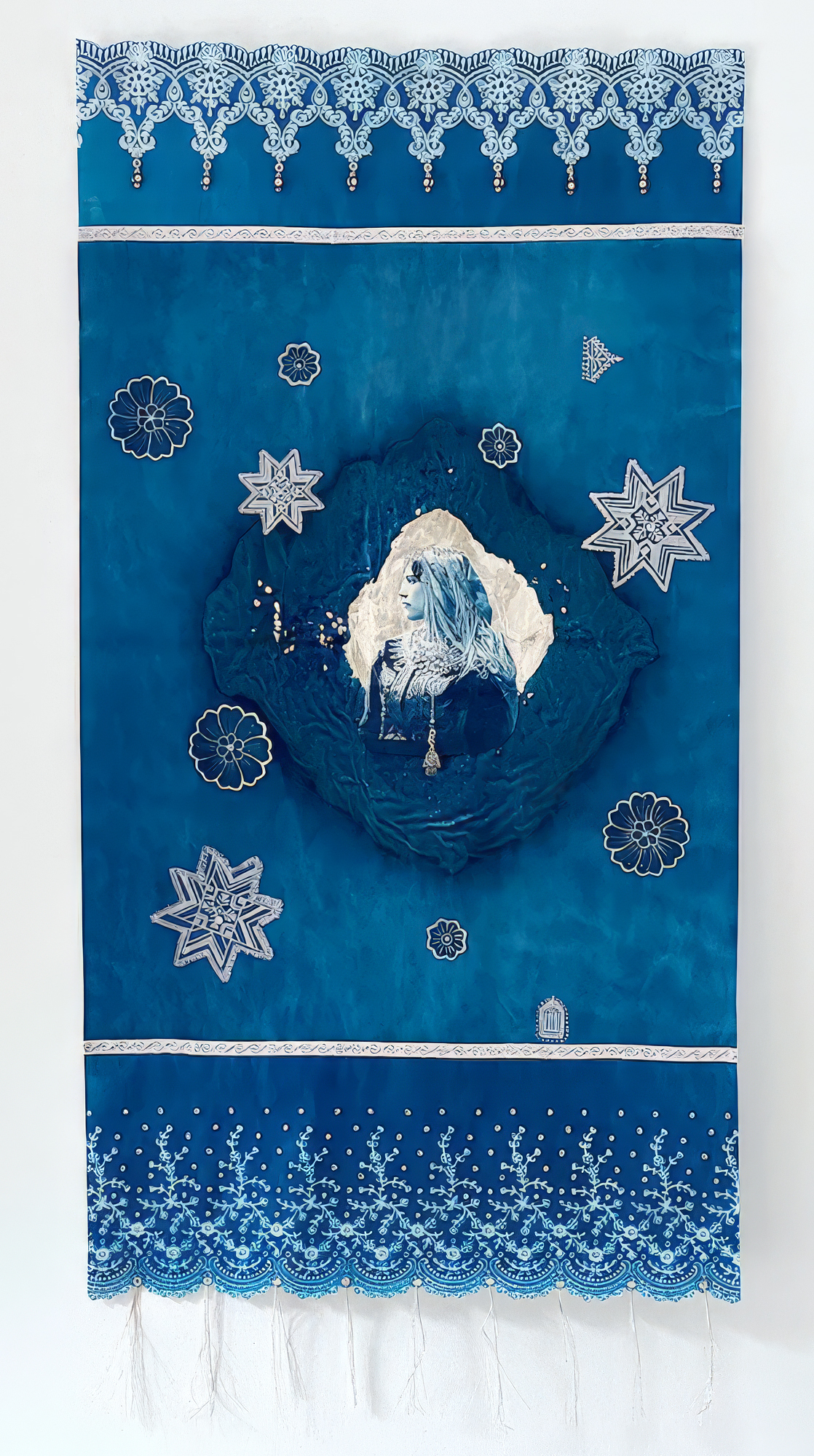
©Fruma Markowitz; Nedunka (Dowry), Cyanotype collage on Hahnemühle Sumi-e paper, fabric trim and sewn beaded elements, embroidery silk tassels, with silver leaf and ink embellishments
Posts on Lenscratch may not be reproduced without the permission of the Lenscratch staff and the photographer.
Recommended
-
Aaron Rothman: The SierraDecember 18th, 2025
-
Gadisse Lee: Self-PortraitsDecember 16th, 2025
-
Scott Offen: GraceDecember 12th, 2025
-
Izabella Demavlys: Without A Face | Richards Family PrizeDecember 11th, 2025
-
2025 What I’m Thankful For Exhibition: Part 2November 27th, 2025

